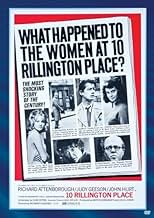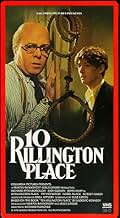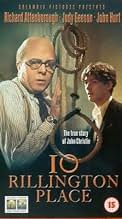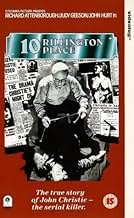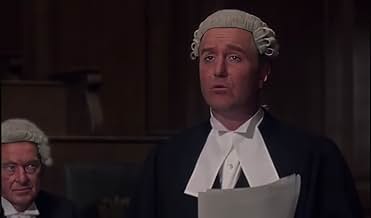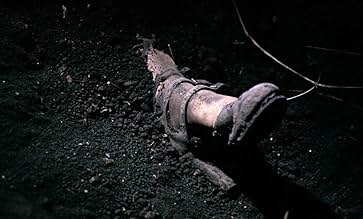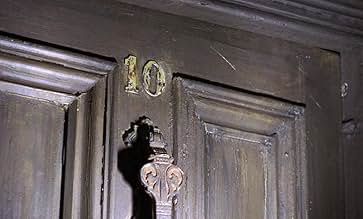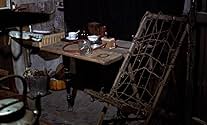L'histoire du tueur en série britannique John Christie, qui a commis la plupart ou la totalité de ses crimes dans la maison mitoyenne du 10 Rillington Place, et l'erreur judiciaire impliquan... Tout lireL'histoire du tueur en série britannique John Christie, qui a commis la plupart ou la totalité de ses crimes dans la maison mitoyenne du 10 Rillington Place, et l'erreur judiciaire impliquant Timothy Evans.L'histoire du tueur en série britannique John Christie, qui a commis la plupart ou la totalité de ses crimes dans la maison mitoyenne du 10 Rillington Place, et l'erreur judiciaire impliquant Timothy Evans.
- Réalisation
- Scénario
- Casting principal
- Nomination aux 1 BAFTA Award
- 1 nomination au total
- Judge Lewis
- (as Andre Morell)
Avis à la une
Fleischer's style is plain;the trial scenes,when any director would have his actors overact is a lesson a lot of the current artists should pay attention to.The hanging could not be spookier.One cannot help but think that the last lines about Tim on the screen are a bit ironical.
Matching Attenborough's awesome portrayal,is John Hurt's remarkable Tim:definitely not Gregory Peck as his wife thinks,macho but pitiful,a not very handsome whining lad who cannot hold a candle to his maleficent owner.
You should see "the Boston strangler" and "10 Rillington place" one after the other
The recreation of one of Britains most famous serial killers crimes and the impact on one family in particular is nothing if not sober in tone.
Director Richard Fleischer had recent "true crime" form with his version of The Boston Strangler 1968, Fleischer shoots with hand-held cameras under realistically dim lighting, creating an intimate close up portrait of the house and its occupants.
As such the performances have to match, and do. Richard Attenboroughs in particular. His portrayal of Christie will come as a shock to those who only know him from the Jurassic Park series or Miracle on 34th Street. John Hurt and Judy Geeson as the young, ill-educated Evans couple do well though Hurts accent is a little wayward early on.
Chillingly portrayed by the great actor Richard Attenborough , Christie was a little mouse of a man who first lured his victims home on some pretext or other, usually by saying that he could perform some desired medical procedure on them, for example, an abortion, which was illegal at the time. Once there, he put them at ease by offering them a cup of tea, deceived them into breathing gas from the pipe, rendering them unconscious, then strangled them. He disposed of the bodies, at first by burying them in the garden, then putting them under the sink in the water closet, and finally by tearing up and replacing floorboards and papering over cupboards.
The primary reasons that Christie was able to do what he did for so long were first of all the war. London was undergoing the blitz, and people had a tendency to disappear during the bombing. Another reason was that he was able to turn the suspicions of the police from him to a not very bright truck driver named Timothy Evans, (played by John Hurt) who was convicted of the death of his baby daughter, and was also suspected in the murder of his wife, but due to English law could only be tried for one or the other of them. He was hanged in 1950. The scene in the film where Evans is hanged is chilling, and quite accurate.
Slow at first and shot on location at the actual scene of the murders, the film shows a dangerous manipulative killer hiding behind a bland, mild exterior. Because he appeared so mild, Christie was all the more terrifying. Attenborough brings this out expertly and the overall effect is very creepy.
This superbly-acted film is British cinema at its' very best.
Cup of tea, anyone?
The movie's not only a reflection on the death penalty, but on anti-abortion laws, as well. Those desperate women wouldn't have been driven into the clutches of the lunatic Cristie were abortion licensed and legal. That may not have stopped his madness, but he would have had to come up with a different ploy.
The movie focuses on one particular episode (the Evans killings) rather than the series of killings that actually covered a considerable time period. So, cooped up in the city, Cristie ends up hiding his many victims where he can (in the garden, in the washroom, in the walls). What surprises me is that no one, least of all, the wife, notices what must have been an atrocious smell.
Note the dispatch with which Evans is hanged, unlike the more ritualized American way. I assume the movie is an accurate depiction. He walks into an ordinary room, the hood is placed over his head, and plop, the trapdoor opens. And it takes just about that long. The suddenness really startled me.
Contrast two ends of the serial killer spectrum—the shy, unattractive Cristie and the charming, handsome Ted Bundy of 1970's America. Understandably, Bundy had no trouble luring girls to their doom; judging from the movie, however, Cristie's victims must have been truly desperate to let that little creep lay hands on them.
Not mentioned in the movie, but in one of the books that I recall, is that Cristie kept swatches of pubic hair as trophies.
Like any good document on serial killers, the film presents a glimpse of lives and social levels that otherwise go unnoticed. Here we get a sense of a decaying part of London and the dreary lives hanging on there. A good movie or book is like a knife slicing through a cake, exposing layers that otherwise remain hidden. That's the particular strength of this film.
My only reservation is the casting of Judy Geeson as Evans' wife. She seems too pretty and smart to be hooked up with a dead-ender like Evans. Still and all, Geeson's performance is excellent— note her subtle expressions on first meeting the creepy Cristie. Nonetheless, I suspect her casting was the one concession the producers made to commercial appeal.
All in all, it's a grim, ugly film-- as it should be. We may not get much sense of why Cristie has taken the warped, monstrous turn he has. But then such dark matters may be beyond us, anyway. Above all, the movie should not be viewed in a depressed state or if you're looking for a room to rent.
Le saviez-vous
- AnecdotesRichard Attenborough's make-up, mainly consisting of a bald pate, took three hours to apply every morning.
- GaffesWhen Christie is explaining the procedure he's about to perform on Beryl, he says that natural gas contains carbon monoxide, then quotes its formula as CO2 (which is actually carbon dioxide). The correct formula for carbon monoxide is CO. However, the point appears to be to show him for the half-educated conman he is. It's just Christie's character creating an air of "expertise".
- Citations
John Reginald Christie: It's the moral question that concerns me, the taking of life - no matter how rudimentary.
Beryl Evans: It's not really... I'd be ever so grateful, Mr Christie.
- Crédits fousPrologue to opening credits: "This is a true story. Whenever possible, the dialogue has been based on official documents"
- ConnexionsFeatured in Interview with Sir Richard Attenborough (2004)
Meilleurs choix
- How long is 10 Rillington Place?Alimenté par Alexa
Détails
- Date de sortie
- Pays d’origine
- Langue
- Aussi connu sous le nom de
- L'étrangleur de Rillington Place
- Lieux de tournage
- 10 Rillington Place, Notting Hill, Londres, Angleterre, Royaume-Uni(location exteriors, still occupied during filming - demolished 1970)
- Sociétés de production
- Voir plus de crédits d'entreprise sur IMDbPro
Contribuer à cette page



